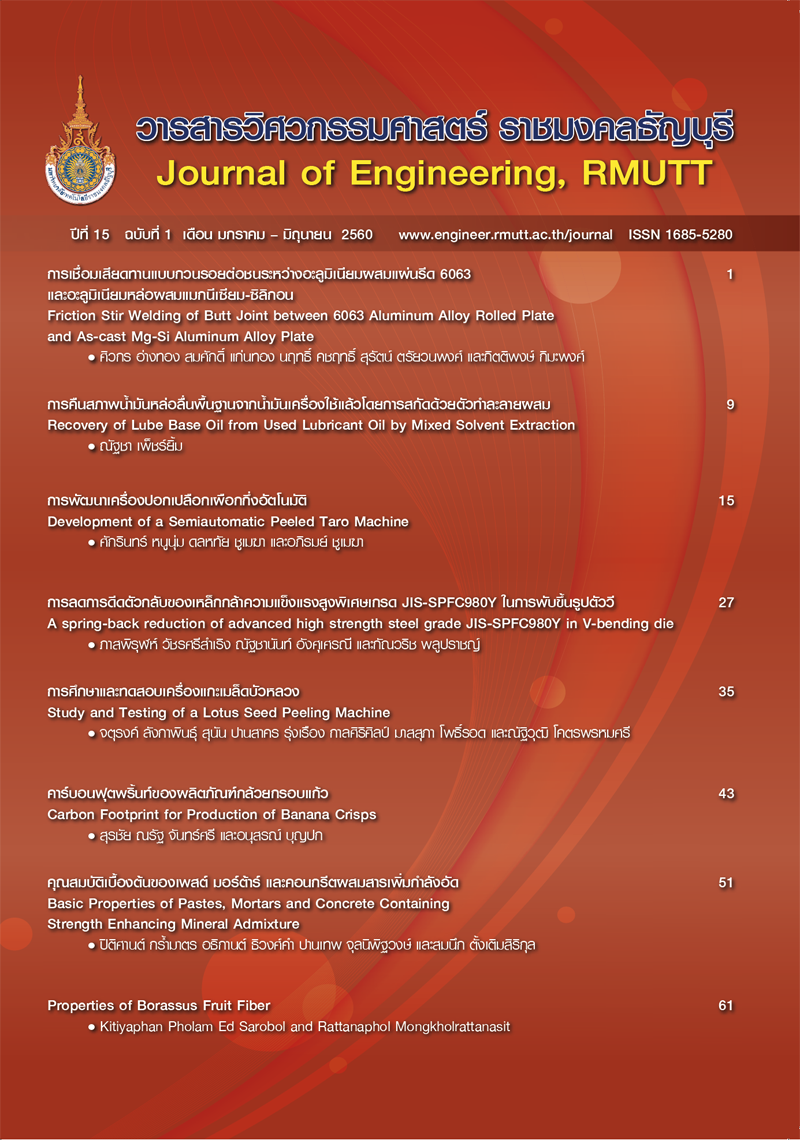Carbon Footprint for Production of Banana Crisps
Main Article Content
Abstract
Carbon footprint for 160 g of sweet banana crisps including with packaging was investigated according to the reference method of carbon footprint for product providing by Thailand Greenhouse Gas Management Organization (Public Organization) (TGO). The scope of study focused on candle to grave or business to customer (B2C). The data was beginning to collect from raw materials and packaging stage, manufacturing processes stage, distribution stage, utilization stage and be finished in disposal stage. Results indicated that the carbon footprint of this product was 0.35 kgCO2eq which was obtained from the procurement and utilization and from the transportation of raw material, energy and resource approximately 0.34 and 0.01 kgCO2eq, respectively. Raw banana was significant for promoting a large number of the greenhouse gas emission in the first stage of scope followed by vegetable oil and sugar. In the manufacturing processes stage, liquefied petroleum gas was the main resource to emit the greenhouse gas a lot however be inferior to the previous one. For reducing the greenhouse gas emission, the producer should be focused on the stage of manufacturing process in term of depth frying.
Article Details
The manuscript, information, content, picture and so forth which were published on Frontiers in engineering innovation research has been a copyright of this journal only. There is not allow anyone or any organize to duplicate all content or some document for unethical publication.
References
ชาตรี ทวีนาท และธนะ ศุกรวัชรินทร์. กล้วยกรอบแก้ว “นกกระจิบ” จ.ชัยภูมิ สุดยอด “OTOP ห้าดาว”. [ออนไลน์] เข้าถึงได้จาก : http:// www.banmuang.co.th (14 กันยายน 2559).
คณะกรรมการเทคนิคด้านคาร์บอนฟุตพริ้นท์ของผลิตภัณฑ์, 2558. แนวทางการประเมินคาร์บอนฟุตพริ้นท์ของผลิตภัณฑ์ ภายใต้โครงการส่งเสริมการใช่คาร์บอนฟุตพริ้นท์ของผลิตภัณฑ์. พิมพ์ครั้งที่ 5. กรุงเทพฯ: องค์การบริหารจัดการก๊าซเรือนกระจก (องค์การมหาชน).
พงษ์เทพ สุวรรณวารี, ขนิษฐา มีวาสนา, กัลยาณี กุลชัย และมนัสวี พานิชนอก, 2557. รายงานการวิจัยเรื่อง วอเตอร์และคาร์บอนฟุตพริ้นท์ของการผลิตน้ำตาลทรายขาวในภาคตะวันออกเฉียงเหนือตอนล่างของประเทศไทย กรณีศึกษา: จังหวัดนครราชสีมา ชัยภูมิ บุรีรัมย์ และสุรินทร์. รายงานวิจัยฉบับสมบูรณ์ มหาวิทยาลัยเทคโนโลยีสุรนารี.
รัตนาวรรณ มั่งคั่ง, แชบเบียร์ กีวาลา, งามทิพย์ ภู่วโดม และสิรินทรเทพ เต้าประยูร, 2554. “คาร์บอนฟุตพริ้นท์ของผลิตภัณฑ์ข้าว,” วิศวกรรมสาร มก. 75, 24 (มกราคม - มีนาคม) : 53-60, 2554.
ปฐม ประสาทเขตการ และสิริลักษณ์ เจียรากร, 2558. “คาร์บอนฟุตพริ้นท์ของกระบวนการแปรรูปเมล็ดกาแฟโรบัสต้าในวิสาหกิจชุมชน”. โครงการประชุมวิชาการเสนอผลงานวิจัยระดับบัณฑิตศึกษาแห่งชาติ ครั้งที่ 34. 27 มีนาคม 2558. มหาวิทยาลัยขอนแก่น.
องค์การบริหารจัดการก๊าซเรือนกระจก (องค์การมหาชน). Emission Factor. [ออนไลน์] เข้าถึงได้จาก: http://thaicarbonlabel.tgo. or.th (10 กันยายน 2559).
องค์การบริหารจัดการก๊าซเรือนกระจก (องค์การมหาชน). บริษัทและผลิตภัณฑ์ที่ขึ้นทะเบียนคาร์บอนฟุตพริ้นท์ของผลิตภัณฑ์. [ออนไลน์] เข้าถึงได้จาก: http://thaicarbonlabel.tgo. or.th (10 กันยายน 2559).


